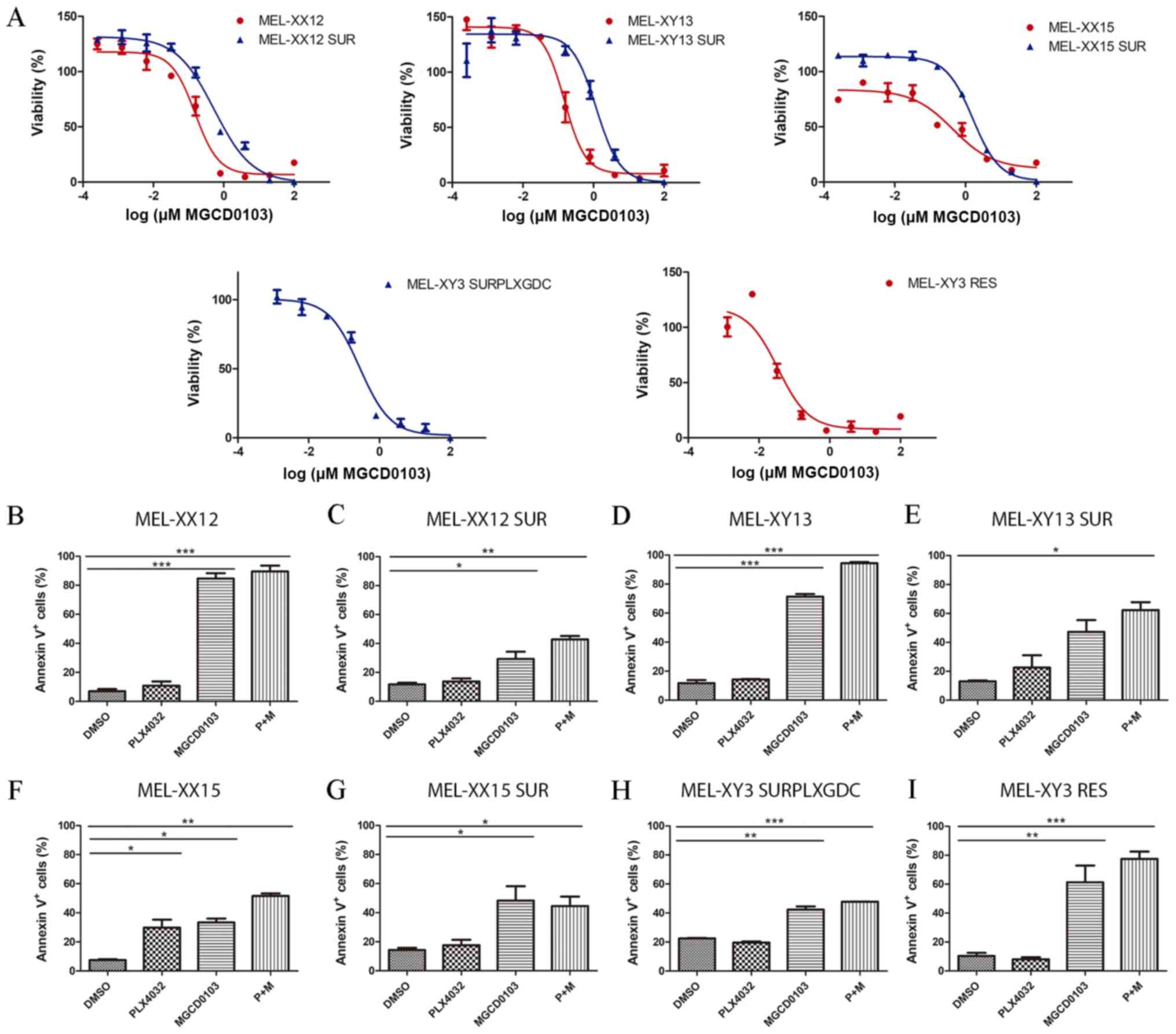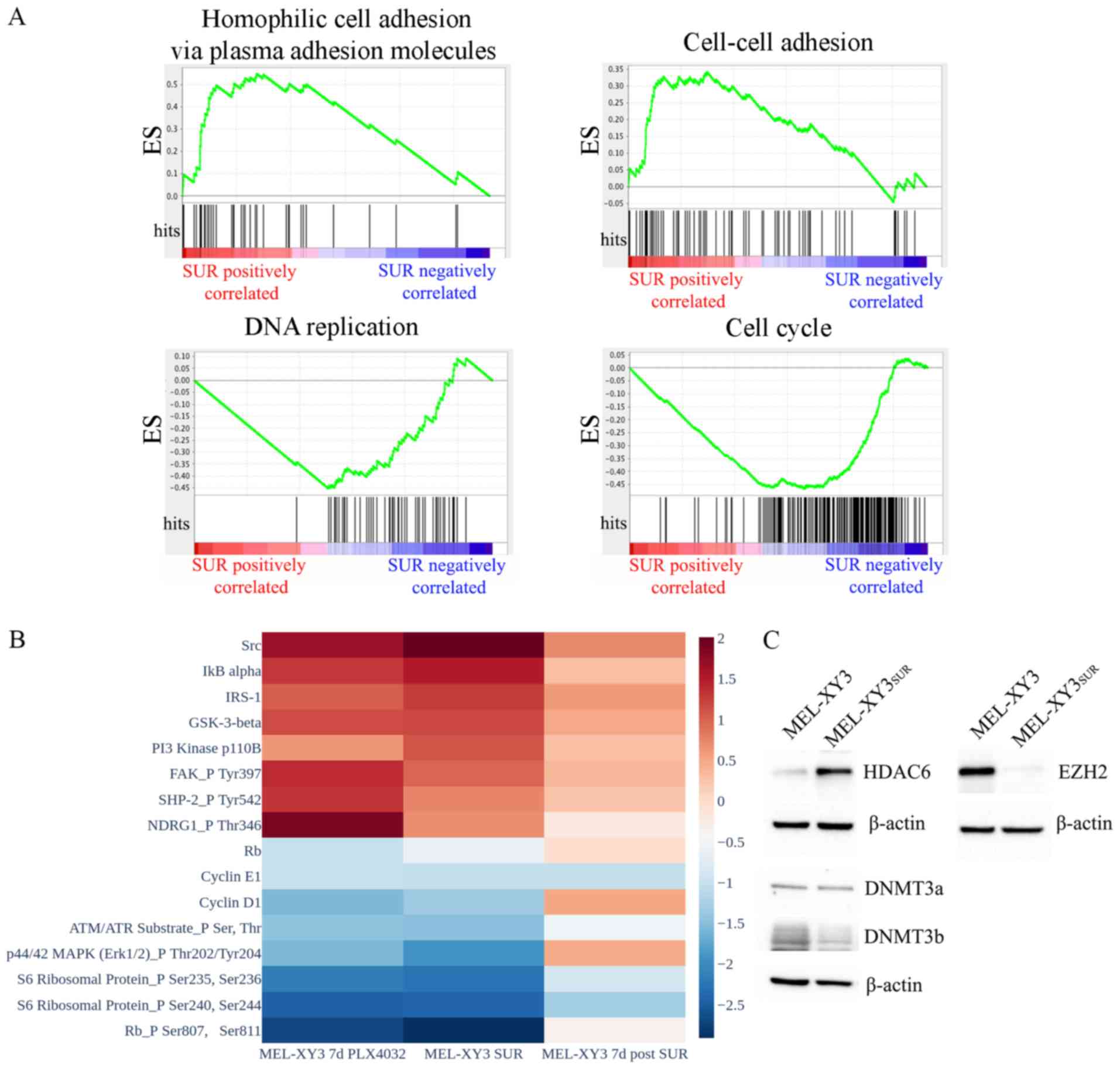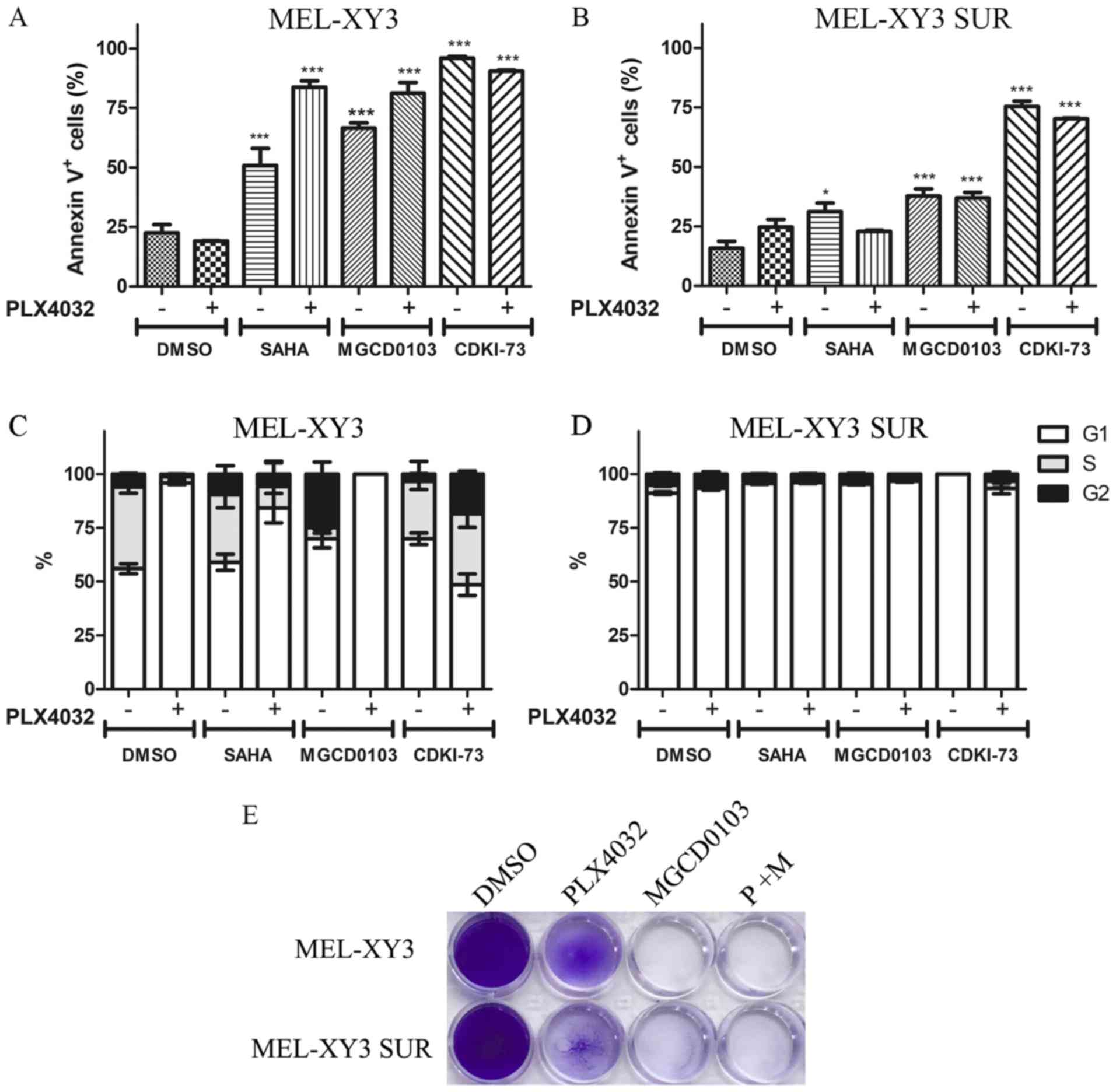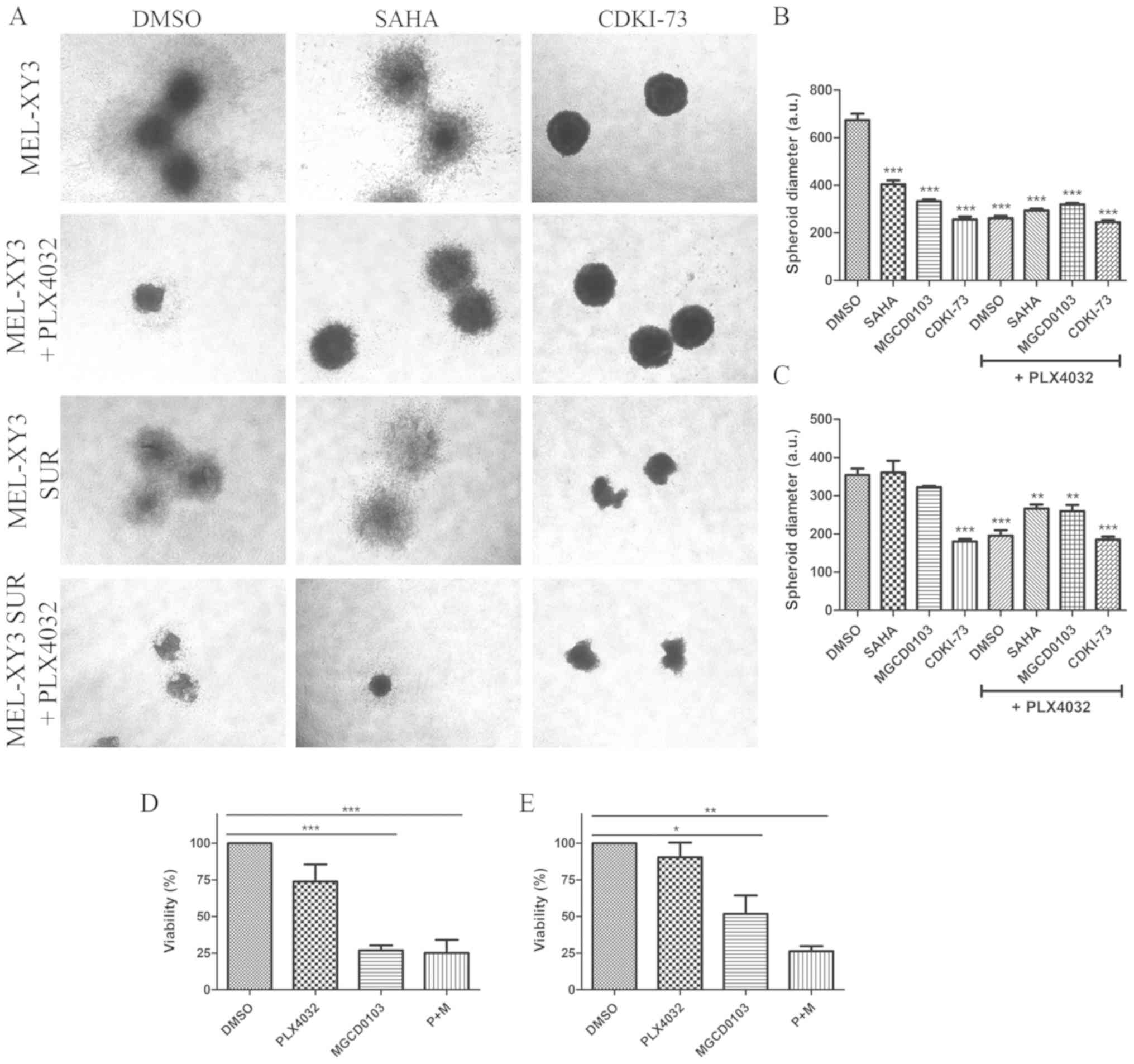|
1
|
Davies H, Bignell GR, Cox C, Stephens P,
Edkins S, Clegg S, Teague J, Woffendin H, Garnett MJ, Bottomley W,
et al: Mutations of the BRAF gene in human cancer. Nature.
417:949–954. 2002. View Article : Google Scholar : PubMed/NCBI
|
|
2
|
Villanueva J, Vultur A and Herlyn M:
Resistance to BRAF inhibitors: Unraveling mechanisms and future
treatment options. Cancer Res. 71:7137–7140. 2011. View Article : Google Scholar : PubMed/NCBI
|
|
3
|
Van Allen EM, Wagle N, Sucker A, Treacy
DJ, Johannessen CM, Goetz EM, Place CS, Taylor-Weiner A, Whittaker
S, Kryukov GV, et al: The genetic landscape of clinical resistance
to RAF inhibition in metastatic melanoma. Cancer Discov. 4:94–109.
2014. View Article : Google Scholar :
|
|
4
|
Nazarian R, Shi H, Wang Q, Kong X, Koya
RC, Lee H, Chen Z, Lee MK, Attar N, Sazegar H, et al: Melanomas
acquire resistance to B-RAF(V600E) inhibition by RTK or N-RAS
upregulation. Nature. 468:973–977. 2010. View Article : Google Scholar : PubMed/NCBI
|
|
5
|
Shi H, Hugo W, Kong X, Hong A, Koya RC,
Moriceau G, Chodon T, Guo R, Johnson DB, Dahlman KB, et al:
Acquired resistance and clonal evolution in melanoma during BRAF
inhibitor therapy. Cancer Discov. 4:80–93. 2014. View Article : Google Scholar :
|
|
6
|
Shi H, Moriceau G, Kong X, Lee MK, Lee H,
Koya RC, Ng C, Chodon T, Scolyer RA, Dahlman KB, et al: Melanoma
whole-exome sequencing identifies (V600E)B-RAF
amplification-mediated acquired B-RAF inhibitor resistance. Nat
Commun. 3:7242012. View Article : Google Scholar : PubMed/NCBI
|
|
7
|
Arozarena I and Wellbrock C: Overcoming
resistance to BRAF inhibitors. Ann Transl Med. 5:3872017.
View Article : Google Scholar : PubMed/NCBI
|
|
8
|
Levesque MP, Cheng PF, Raaijmakers MI,
Saltari A and Dummer R: Metastatic melanoma moves on: Translational
science in the era of personalized medicine. Cancer Metastasis Rev.
36:7–21. 2017. View Article : Google Scholar : PubMed/NCBI
|
|
9
|
Rambow F, Rogiers A, Marin-Bejar O, Aibar
S, Femel J, Dewaele M, Karras P, Brown D, Chang YH, Debiec-Rychter
M, et al: Toward minimal residual disease-directed therapy in
melanoma. Cell. 174:843–855 e819. 2018. View Article : Google Scholar : PubMed/NCBI
|
|
10
|
Strauss J and Figg WD: Epigenetic
approaches to overcoming chemotherapy resistance. Lancet Oncol.
16:1013–1015. 2015. View Article : Google Scholar : PubMed/NCBI
|
|
11
|
Zeller C, Dai W, Steele NL, Siddiq A,
Walley AJ, Wilhelm-Benartzi CS, Rizzo S, van der Zee A, Plumb JA
and Brown R: Candidate DNA methylation drivers of acquired
cisplatin resistance in ovarian cancer identified by methylome and
expression profiling. Oncogene. 31:4567–4576. 2012. View Article : Google Scholar : PubMed/NCBI
|
|
12
|
Giessrigl B, Schmidt WM, Kalipciyan M,
Jeitler M, Bilban M, Gollinger M, Krieger S, Jäger W, Mader RM and
Krupitza G: Fulvestrant induces resistance by modulating GPER and
CDK6 expression: Implication of methyltransferases, deacetylases
and the hSWI/SNF chromatin remodelling complex. Br J Cancer.
109:2751–2762. 2013. View Article : Google Scholar : PubMed/NCBI
|
|
13
|
Shen Y, Tong M, Liang Q, Guo Y, Sun HQ,
Zheng W, Ao L, Guo Z and She F: Epigenomics alternations and
dynamic transcriptional changes in responses to 5-fluorouracil
stimulation reveal mechanisms of acquired drug resistance of
colorectal cancer cells. Pharmacogenomics J. 18:23–28. 2018.
View Article : Google Scholar :
|
|
14
|
Song C, Piva M, Sun L, Hong A, Moriceau G,
Kong X, Zhang H, Lomeli S, Qian J, Yu CC, et al: Recurrent tumor
Cell-intrinsic and -extrinsic alterations during MAPKi-induced
melanoma regression and early adaptation. Cancer Discov.
7:1248–1265. 2017. View Article : Google Scholar : PubMed/NCBI
|
|
15
|
Strub T, Ghiraldini FG, Carcamo S, Li M,
Wroblewska A, Singh R, Goldberg MS, Hasson D, Wang Z, Gallagher SJ,
et al: SIRT6 haploinsufficiency induces BRAFV600E
melanoma cell resistance to MAPK inhibitors via IGF signalling. Nat
Commun. 9:34402018. View Article : Google Scholar
|
|
16
|
Wang L, Leite de Oliveira R, Huijberts S,
Bosdriesz E, Pencheva N, Brunen D, Bosma A, Song JY, Zevenhoven J,
et al: An acquired vulnerability of Drug-resistant melanoma with
therapeutic potential. Cell. 173:1413–1425.e14. 2018. View Article : Google Scholar : PubMed/NCBI
|
|
17
|
Gallagher SJ, Gunatilake D, Beaumont KA,
Sharp DM, Tiffen JC, Heinemann A, Weninger W, Haass NK, Wilmott JS,
Madore J, et al: HDAC inhibitors restore BRAF-inhibitor sensitivity
by altering PI3K and survival signalling in a subset of melanoma.
Int J Cancer. 142:1926–1937. 2018. View Article : Google Scholar
|
|
18
|
Zhao B, Cheng X and Zhou X: The
BET-bromodomain inhibitor JQ1 mitigates vemurafenib drug resistance
in melanoma. Melanoma Res. 28:521–526. 2018. View Article : Google Scholar : PubMed/NCBI
|
|
19
|
Zakharia Y, Monga V, Swami U, Bossler AD,
Freesmeier M, Frees M, Khan M, Frydenlund N, Srikantha R, Vanneste
M, et al: Targeting epigenetics for treatment of BRAF mutated
metastatic melanoma with decitabine in combination with
vemurafenib: A phase lb study. Oncotarget. 8:89182–89193. 2017.
View Article : Google Scholar : PubMed/NCBI
|
|
20
|
Madorsky Rowdo FP, Barón A, von Euw EM and
Mordoh J: In vitro long-term treatment with MAPK inhibitors induces
melanoma cells with resistance plasticity to inhibitors while
retaining sensitivity to CD8 T cells. Oncol Rep. 37:1367–1378.
2017. View Article : Google Scholar : PubMed/NCBI
|
|
21
|
Ravindran Menon D, Das S, Krepler C,
Vultur A, Rinner B, Schauer S, Kashofer K, Wagner K, Zhang G,
Bonyadi Rad E, et al: A stress-induced early innate response causes
multidrug tolerance in melanoma. Oncogene. 34:4448–4459. 2015.
View Article : Google Scholar :
|
|
22
|
Gallagher SJ, Tiffen JC and Hersey P:
Histone modifications, modifiers and readers in melanoma resistance
to targeted and immune therapy. Cancers (Basel). 7:1959–1982. 2015.
View Article : Google Scholar
|
|
23
|
Long GV, Hauschild A, Santinami M,
Atkinson V, Mandalà M, Chiarion-Sileni V, Larkin J, Nyakas M,
Dutriaux C, Haydon A, et al: Adjuvant dabrafenib plus trametinib in
stage III BRAF-mutated melanoma. N Engl J Med. 377:1813–1823. 2017.
View Article : Google Scholar : PubMed/NCBI
|
|
24
|
Dobin A, Davis CA, Schlesinger F, Drenkow
J, Zaleski C, Jha S, Batut P, Chaisson M and Gingeras TR: STAR:
Ultrafast universal RNA-seq aligner. Bioinformatics. 29:15–21.
2013. View Article : Google Scholar
|
|
25
|
Anders S, Pyl PT and Huber W: HTSeq-a
Python framework to work with high-throughput sequencing data.
Bioinformatics. 31:166–169. 2015. View Article : Google Scholar
|
|
26
|
R Core Team: R: a language and environment
for statistical computing. R Foundation for Statistical Computing;
Vienna: 2015, https://www.R-project.org/.
|
|
27
|
Robinson MD, McCarthy DJ and Smyth GK:
edgeR: A Bioconductor package for differential expression analysis
of digital gene expression data. Bioinformatics. 26:139–140. 2010.
View Article : Google Scholar
|
|
28
|
Subramanian A, Tamayo P, Mootha VK,
Mukherjee S, Ebert BL, Gillette MA, Paulovich A, Pomeroy SL, Golub
TR, Lander ES and Mesirov JP: Gene set enrichment analysis: A
knowledge-based approach for interpreting genome-wide expression
profiles. Proc Natl Acad Sci USA. 102:15545–15550. 2005. View Article : Google Scholar : PubMed/NCBI
|
|
29
|
Edgar R, Domrachev M and Lash EM: Gene
expression omnibus: NCBI Gene expression and hybridization array
data repository. Nucleic Acids Res. 30:207–210. 2002. View Article : Google Scholar :
|
|
30
|
Rizos H, Menzies AM, Pupo GM, Carlino MS,
Fung C, Hyman J, Haydu LE, Mijatov B, Becker TM, Boyd SC, et al:
BRAF inhibitor resistance mechanisms in metastatic melanoma:
Spectrum and clinical impact. Clin Cancer Res. 20:1965–1977. 2014.
View Article : Google Scholar : PubMed/NCBI
|
|
31
|
Girotti MR, Lopes F, Preece N,
Niculescu-Duvaz D, Zambon A, Davies L, Whittaker S, Saturno G,
Viros A, Pedersen M, et al: Paradox-breaking RAF inhibitors that
also target SRC are effective in drug-resistant BRAF mutant
melanoma. Cancer Cell. 27:85–96. 2015. View Article : Google Scholar :
|
|
32
|
Weiler M, Blaes J, Pusch S, Sahm F,
Czabanka M, Luger S, Bunse L, Solecki G, Eichwald V, Jugold M, et
al: mTOR target NDRG1 confers MGMT-dependent resistance to
alkylating chemotherapy. Proc Natl Acad Sci USA. 111:409–414. 2014.
View Article : Google Scholar
|
|
33
|
Fournel M, Bonfils C, Hou Y, Yan PT,
Trachy-Bourget MC, Kalita A, Liu J, Lu AH, Zhou NZ, Robert MF, et
al: MGCD0103, a novel isotype-selective histone deacetylase
inhibitor, has broad spectrum antitumor activity in vitro and in
vivo. Mol Cancer Ther. 7:759–768. 2008. View Article : Google Scholar : PubMed/NCBI
|
|
34
|
Diaz-Nunez M, Diez-Torre A, De Wever O,
Andrade R, Arluzea J, Silió M and Aréchaga J: Histone deacetylase
inhibitors induce invasion of human melanoma cells in vitro via
differential regulation of N-cadherin expression and RhoA activity.
BMC Cancer. 16:6672016. View Article : Google Scholar : PubMed/NCBI
|
|
35
|
Emran Al A, Marzese DM, Menon DR, Stark
MS, Torrano J, Hammerlindl H, Zhang G, Brafford P, Salomon MP,
Nelson N, et al: Distinct histone modifications denote early
stress-induced drug tolerance in cancer. Oncotarget. 9:8206–8222.
2017.
|
|
36
|
Guler GD, Tindell CA, Pitti R, Wilson C,
Nichols K, KaiWai Cheung T, Kim HJ, Wongchenko M, Yan Y, Haley B,
et al: Repression of Stress-induced LINE-1 expression protects
cancer cell subpopulations from lethal drug exposure. Cancer Cell.
32:221–237 e213. 2017. View Article : Google Scholar : PubMed/NCBI
|
|
37
|
Easwaran HP and Baylin SB: Role of nuclear
architecture in epigenetic alterations in cancer. Cold Spring Harb
Symp Quant Biol. 75:507–515. 2010. View Article : Google Scholar
|
|
38
|
Haferkamp S, Borst A, Adam C, Becker TM,
Motschenbacher S, Windhövel S, Hufnagel AL, Houben R and
Meierjohann S: Vemurafenib induces senescence features in melanoma
cells. J Invest Dermatol. 133:1601–1609. 2013. View Article : Google Scholar : PubMed/NCBI
|
|
39
|
Krayem M, Najem A, Journe F, Morandini R,
Sales F, Awada A and Ghanem GE: Acquired resistance to BRAFi
reverses senescence-like phenotype in mutant BRAF melanoma.
Oncotarget. 9:31888–31903. 2018. View Article : Google Scholar : PubMed/NCBI
|
|
40
|
Childs BG, Baker DJ, Kirkland JL, Campisi
J and van Deursen JM: Senescence and apoptosis: Dueling or
complementary cell fates? EMBO Rep. 15:1139–1153. 2014. View Article : Google Scholar : PubMed/NCBI
|
|
41
|
Grimm J, Hufnagel A, Wobser M, Borst A,
Haferkamp S, Houben R and Meierjohann S: BRAF inhibition causes
resilience of melanoma cell lines by inducing the secretion of
FGF1. Oncogenesis. 7:712018. View Article : Google Scholar : PubMed/NCBI
|
|
42
|
Yu Y, Schleich K, Yue B, Ji S, Lohneis P,
Kemper K, Silvis MR, Qutob N, van Rooijen E, Werner-Klein M, et al:
Targeting the Senescence-overriding cooperative activity of
structurally unrelated H3K9 demethylases in melanoma. Cancer Cell.
33:322–336.e8. 2018. View Article : Google Scholar : PubMed/NCBI
|
|
43
|
Duchmann M and Itzykson R: Clinical update
on hypomethylating agents. Int J Hematol. 110:161–169. 2019.
View Article : Google Scholar : PubMed/NCBI
|
|
44
|
Italiano A, Soria JC, Toulmonde M, Michot
JM, Lucchesi C, Varga A, Coindre JM, Blakemore SJ, Clawson A,
Suttle B, et al: Tazemetostat, an EZH2 inhibitor, in relapsed or
refractory B-cell non-Hodgkin lymphoma and advanced solid tumours:
A first-in-human, open-label, phase 1 study. Lancet Oncol.
19:649–659. 2018. View Article : Google Scholar : PubMed/NCBI
|
|
45
|
Doroshow DB, Eder JP and LoRusso PM: BET
inhibitors: A novel epigenetic approach. Ann Oncol. 28:1776–1787.
2017. View Article : Google Scholar : PubMed/NCBI
|
|
46
|
Pawar A, Gollavilli PN, Wang S and
Asangani IA: Resistance to BET inhibitor leads to alternative
therapeutic vulnerabilities in castration-resistant prostate
cancer. Cell Rep. 29:13972019. View Article : Google Scholar : PubMed/NCBI
|
|
47
|
Suraweera A, O'Byrne KJ and Richard DJ:
Combination therapy with histone deacetylase inhibitors (HDACi) for
the treatment of cancer: Achieving the full therapeutic potential
of HDACi. Front Oncol. 8:922018. View Article : Google Scholar : PubMed/NCBI
|
|
48
|
Sharma SV, Lee DY, Li B, Quinlan MP,
Takahashi F, Maheswaran S, McDermott U, Azizian N, Zou L, Fischbach
MA, et al: A chromatin-mediated reversible drug-tolerant state in
cancer cell subpopulations. Cell. 141:69–80. 2010. View Article : Google Scholar : PubMed/NCBI
|
|
49
|
Haas NB, Quirt I, Hotte S, McWhirter E,
Polintan R, Litwin S, Adams PD, McBryan T, Wang L, Martin LP, et
al: Phase II trial of vorinostat in advanced melanoma. Invest New
Drugs. 32:526–534. 2014. View Article : Google Scholar : PubMed/NCBI
|
|
50
|
Jeffries MA and Sawalha AH: Autoimmune
disease in the epigenetic era: How has epigenetics changed our
understanding of disease and how can we expect the field to evolve?
Expert Rev Clin Immunol. 11:45–58. 2015. View Article : Google Scholar :
|
|
51
|
Mohammadi A, Sharifi A, Pourpaknia R,
Mohammadian S and Sahebkar A: Manipulating macrophage polarization
and function using classical HDAC inhibitors: Implications for
autoimmunity and inflammation. Crit Rev Oncol Hematol. 128:1–18.
2018. View Article : Google Scholar : PubMed/NCBI
|
|
52
|
Patel U, Rajasingh S, Samanta S, Cao T,
Dawn B and Rajasingh J: Macrophage polarization in response to
epigenetic modifiers during infection and inflammation. Drug Discov
Today. 22:186–193. 2017. View Article : Google Scholar :
|
|
53
|
Mangano K, Fagone P, Bendtzen K, Meroni
PL, Quattrocchi C, Mammana S, Di Rosa M, Malaguarnera L, Coco M and
Magro G: Hypomethylating agent 5-aza-2′-deoxycytidine (DAC)
ameliorates multiple sclerosis in mouse models. J Cell Physiol.
229:1918–1925. 2014. View Article : Google Scholar : PubMed/NCBI
|
|
54
|
Fagone P, Mazzon E, Chikovani T, Saraceno
A, Mammana S, Colletti G, Mangano K, Bramanti P and Nicoletti F:
Decitabine induces regulatory T cells, inhibits the production of
IFN-gamma and IL-17 and exerts preventive and therapeutic efficacy
in rodent experimental autoimmune neuritis. J Neuroimmunol.
321:41–48. 2018. View Article : Google Scholar : PubMed/NCBI
|
|
55
|
Younes A, Oki Y, Bociek RG, Kuruvilla J,
Fanale M, Neelapu S, Copeland A, Buglio D, Galal A, Besterman J, et
al: Mocetinostat for relapsed classical Hodgkin's lymphoma: An
open-label, single-arm, phase 2 trial. Lancet Oncol. 12:1222–1228.
2011. View Article : Google Scholar : PubMed/NCBI
|
|
56
|
Briere D, Sudhakar N, Woods DM, Hallin J,
Engstrom LD, Aranda R, Chiang H, Sodré AL, Olson P, Weber JS and
Christensen JG: The class I/IV HDAC inhibitor mocetinostat
increases tumor antigen presentation, decreases immune suppressive
cell types and augments checkpoint inhibitor therapy. Cancer
Immunol Immunother. 67:381–392. 2018. View Article : Google Scholar
|
|
57
|
Zhang H, Pandey S, Travers M, Sun H,
Morton G, Madzo J, Chung W, Khowsathit J, Perez-Leal O, Barrero CA,
et al: Targeting CDK9 reactivates epigenetically silenced genes in
cancer. Cell. 175:1244–1258.e1226. 2018. View Article : Google Scholar : PubMed/NCBI
|
|
58
|
Lam F, Abbas AY, Shao H, Teo T, Adams J,
Li P, Bradshaw TD, Fischer PM, Walsby E, Pepper C, et al: Targeting
RNA transcription and translation in ovarian cancer cells with
phar-macological inhibitor CDKI-73. Oncotarget. 5:7691–7704. 2014.
View Article : Google Scholar : PubMed/NCBI
|



















